This is the plot I want:
This is my code so far (but it does not give me the results I want):
color_scale_class <- c("#00aedb", "#ff6f69", "#ffcc5c", "#cbe885", "#88d8b0")
ggplot(fluct_all, aes(x=type, y=test_acc, color=as.factor(fold), fill=type)) +
stat_boxplot(geom = "errorbar") +
geom_boxplot(outlier.alpha = 0.01, outlier.size = 0.75) +
scale_fill_manual(values = color_scale_class,
name = "Input Data\nCombination",
labels = c("TLS", "TLS & GEO", "TLS & RGB", "ALL")) +
scale_color_manual(values=rep("black", 5)) +
theme_light() +
theme(text = element_text(size = 14, family="Calibri")) +
scale_x_discrete(labels = c("TLS", "TLS & GEO", "TLS & RGB", "ALL")) +
xlab("") +
ylab("Test Accuracy\n") +
guides(color = "none")
However, I have several issues: I want the whiskers to have small horizontal lines. I tried to do it by stat_boxplot(geom = "errorbar") but this only works when I keep the width on default. I want a width of 0.2 though. But when I do this, the errorbars do not horizontally align with the boxplots.
My second issue: I want one boxplot for each "fold", but I want the colors to be based on the "type". I managed to get the seperate plots by using fill=as.factor(fold), but then I don't manage to get colors referring to the "type".
I would like to avoid using facets, since I want everything on one plot. Any help is highly appreciated! Basically my issue is that I want several boxplots based on one variable, which I achieve with fill, but I want the color to be referring to another variable actually.
I have some dummy data here:
fluct_all <- data.frame(
"type" = rep(c("tls", "tls_rgb", "tls_geo", "tls_rgb_geo"), each=50),
"fold" = rep(1:5, 10),
"test_acc" = rnorm(200))
Edit: I just got an idea and fixed the color issue (sorry!), but my whiskers of stat_boxplot still do not align with geom_boxplot.
